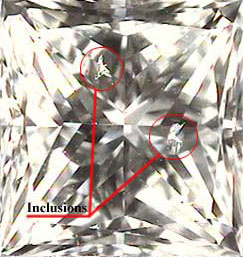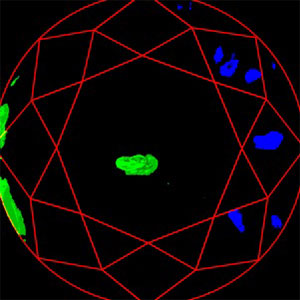Diamond clarity meets Artificial Intelligence
The 4 Cs – color, clarity, carat weight and cut – are basic to describing a diamond and determining its value. Gemologists have found Clarity grading the most difficult and time-consuming part of diamond grading. That’s up for a big change.
The Gemological Institute of America and IBM Research have joined forces to create an automated clarity-grading system for diamonds.
 Clarity is the term used to describe the internal quality of a gem. Over the years GIA’s color and cut grading have become largely automated, but clarity proved to be more complex. The diamonds must be examined for inclusions, cracks, spots, clouds, or any other blemish or imperfection of any sort, all of which affect the value of the stone.
Clarity is the term used to describe the internal quality of a gem. Over the years GIA’s color and cut grading have become largely automated, but clarity proved to be more complex. The diamonds must be examined for inclusions, cracks, spots, clouds, or any other blemish or imperfection of any sort, all of which affect the value of the stone.
It takes a trained and practiced eye to do this assessment, and then to accurately plot the findings on a diagram of the stone. A big job for a human.
With the new AI system, digital images of the stone are sent to the cloud and compared with data from tens of millions of diamonds GIA has examined in the past. Artificial intelligence developed by IBM then evaluates the overall effect of the diamond’s clarity and computes a clarity grade, based on the grading standard developed by GIA.
The picture above is a snapshot of the new software determining a clarity grade.
Tom Moses, GIA’s chief laboratory and research officer, called clarity “the last frontier” in grading by machine. He assures us that humans will continue to be involved, since there’s a lot of nuance in diamond grading, especially for larger stones. “The human visual system is complex,” he says. “It’s hard to find a camera and lens that completely does what the human visual system does.”
The advantage of the AI clarity system is that it will improve the speed and consistency of clarity grading. It is also likely to make diamond grading services more affordable, especially for smaller stones.
Sarine AI systems
Other labs have also been developing artificial intelligence systems for analyzing gems. Sarine Technologies introduced automated color grading and clarity mapping equipment in 2016. The Sarine tools are valuable for diamond cutters, because knowing the size and location of inclusions in the diamond rough is an extremely useful and necessary guide for cutting and shaping the gem.
Manufacturers can order individual stones according to the size, cut, color, and quality of the final polished gems they require, and Sarine will supply the appropriate rough. The company also produces systems that allow diamond retailers and their customers to “explore the diamond at near microscopic levels.”
Clarity enhancement disclosure
 Mined diamonds of highest clarity are extremely rare and priced far beyond the reach of most jewelry buyers. Almost all diamonds have inclusions or blemishes of one kind or another.
Mined diamonds of highest clarity are extremely rare and priced far beyond the reach of most jewelry buyers. Almost all diamonds have inclusions or blemishes of one kind or another.
Typically, when a diamond is being graded, the stone is first examined at a very high power to see what inclusions are visible. Then power is reduced to 10X, where only the more serious flaws remain visible.
One expert points out that no two diamonds are alike, and that inclusions in a particular stone are like its fingerprint, identifying it among all others. Some sellers refer to a stone’s unique blemishes as beauty marks.
But excessive inclusions or fractures make the diamond unattractive. Clarity enhancements such as laser drilling and fracture filling are used to disguise flaws, so the diamond looks more appealing. Once treated, the diamond has a better appearance but it still has the fracture or drill hole, which weakens the stone, making it more likely to crack.
Clarity treatments should be disclosed by the seller and on the appraisal, but often they are not.
GIA does not grade diamonds that have been fracture-filled because the treatment is unstable and can harm the stone. The lab discloses other treatments in the “Comments” section of the report.
GIA offers a variety of diamond reports, which vary in price and in completeness of the information carried. See our GIA Diamond Reports for a detailed discussion.
FOR AGENTS & UNDERWRITERS
Diamond treatments have a huge effect on valuation. Appraisals and lab reports should disclose any color and clarity treatments (enhancements) done to the gem, or state that the stone is untreated.
Beware of an SI3 clarity grade. The widely used GIA clarity scale does not have this grade. The appraiser (often the jewelry retailer) is trying to avoid listing the grade as I1, meaning that inclusions are visible without the aid of a loupe or microscope. If this grade appears, be wary of all quality descriptions on the appraisal.
You can verify a GIA lab report you receive by following this link:
GIA Report Check
FOR ADJUSTERS
Carefully examine the appraisal and other documents for any mention of color or clarity enhancements, as these treatments can greatly affect the value of the diamond and require further disclosure.
Failure of fracture-filling is inherent vice and is not damage for which the insurer is liable, as it is a specifically excluded peril.
If you are settling a claim based on an appraisal that grades a diamond as SI3, be aware that this bogus grade is the equivalent of I1. In communicating with jewelers about a replacement, it would be better to give the grade as I1, since this follows the GIA clarity grading system.
For a damage claim, always have the gem examined in a gem lab by a trained gemologist (GG, FGA+ or equivalent), preferably one who has additional insurance appraisal training. One course offering such additional training is the Certified Insurance Appraiser™ (CIA) course of the Jewelry Insurance Appraisal Institute.
©2000-2024, JCRS Inland Marine Solutions, Inc. All Rights Reserved. www.jcrs.com


